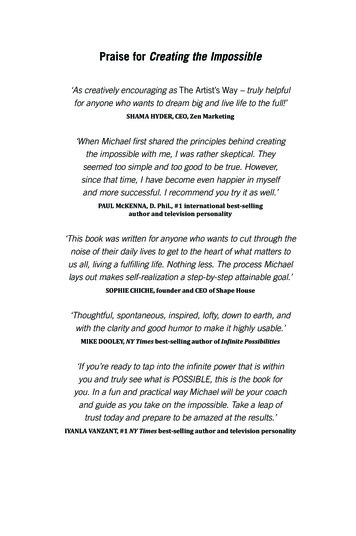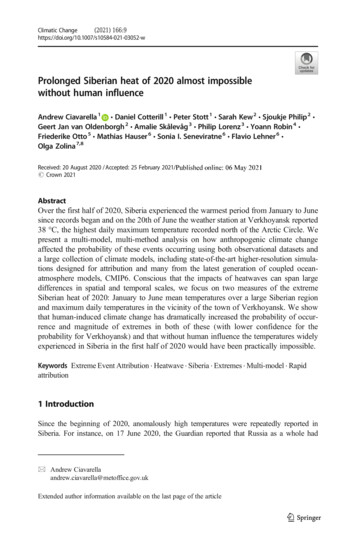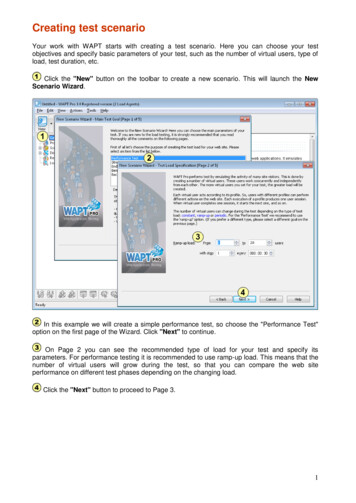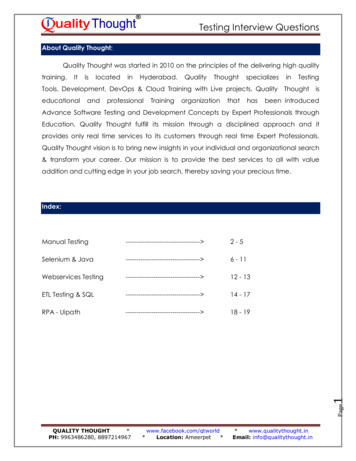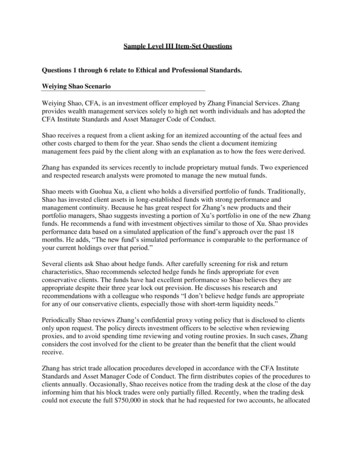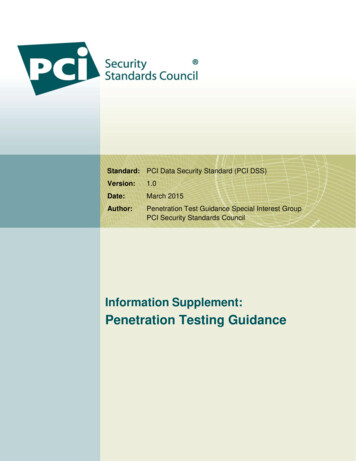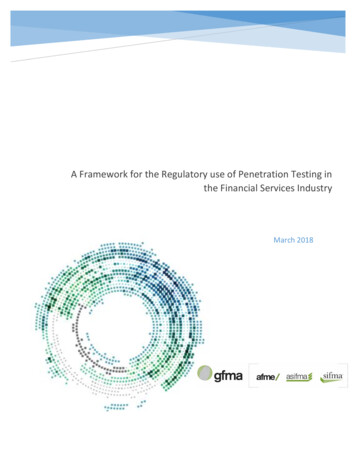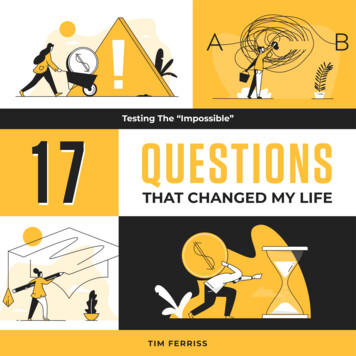
Transcription
ATesting The “Impossible”1717QUESTIONSTHAT CHANGED MY LIFETIM FER R I S SB
“Whenever you find yourself on the side of the majority, it is time to pause and reflect.”— Mark TwainReality is largely negotiable.If you stress-test the boundaries and experiment with the “impossibles,” you’ll quickly discoverthat most limitations are a fragile collection of socially reinforced rules you can choose to breakat any time.What follows are 17 questions that have dramatically changed my life. Each one is time stamped,as they entered the picture at precise moments.
#1W h at i f I d i d the op p osite for 4 8 hours?In 2000, I was selling mass data storage to CEOs and CTOs in my first job out of college. When Iwasn’t driving my mom’s hand-me-down minivan to and from the office in San Jose, California, Iwas cold calling and cold emailing. “Smiling and dialing” was brutal. For the first few months, Iflailed and failed (it didn’t help that my desk was wedged in a fire exit). Then one day I realizedsomething: all of the sales guys made their sales calls between 9 a.m. and 5 p.m. Obvious, right?But that’s part one. Part two: I realized that all of the gatekeepers who kept me from the decisionmakers—CEOs and CTOs—also worked from 9 to 5. What if I did the opposite of all the othersales guys, just for 48 hours? I decided to take a Thursday and Friday and make sales calls onlyfrom 7 to 8:30 a.m. and 6 to 7:30 p.m. For the rest of the day, I focused on cold emails. It workedlike gangbusters. The big boss often picked up the phone directly, and I began doing moreexperiments with “What if I did the opposite?”: What if I only asked questions instead ofpitching? What if I studied technical material so I sounded like an engineer instead of a salesguy? What if I ended my emails with “I totally understand if you’re too busy to reply, and thankyou for reading this far,” instead of the usual “I look forward to your reply and speaking soon”presumptuous BS? The experiments paid off. My last quarter in that job, I outsold the entire L.A.office of our biggest competitor, EMC.
#2W h at d o I s pend a silly amount of money on? H ow might Isc r a t c h m y own itch?In late 2000 and early 2001, I saw the writing on the wall: the startup I worked for was going toimplode. Rounds of layoffs had started and weren’t going to end. I wasn’t sure what to do, butI’d been bitten by the startup bug and intoxicated by Silicon Valley. To explore businessopportunities, I didn’t do in-depth market research; I started with my credit card statement andasked myself, “What do I spend a silly amount of money on?” Where did I spend adisproportionate amount of my income? Where was I price insensitive? The answer was sportssupplements. At the time, I was making less than 40K a year and spending 500 or more permonth on supplements. It was insane, but dozens of my male friends were equally overboard. Ialready knew which ads got me to buy, which stores and websites I used to purchase goods,which bulletin boards I frequented, and all the rest. Could I create a product that would scratchmy own itch? What was I currently cobbling together (I had enough science background to bedangerous) that I couldn’t conveniently find at retail? The result was a cognitive enhancer calledBrainQUICKEN. Before everyone got fired, I begged my coworkers to each prepay for a bottle,which gave me enough money to hire chemists, a regulatory consultant, and do a tinymanufacturing run. I was off to the races.750mgBOOSTFuelPOWERSPORTS60P OW E R30%
#3Wh at wo u l d I d o/have /b e if I had 1 0 million? What ’s my realTM I ?In 2004, I was doing better than ever financially, and BrainQUICKEN was distributed in perhaps adozen countries. The problem? I was running on caffeine, working 15-hour days, and constantlyon the verge of meltdown. My girlfriend, whom I expected to marry, left me due to theworkaholism. Over the next six months of treading water and feeling trapped, I realized I had torestructure the business or shut it down—it was literally killing me. This is when I beganjournaling on a few questions, including “What would I want to do, have, and be if I had 10million in the bank?” and “What’s my real target monthly income (TMI)?” For the latter, in otherwords: How much does my dream life—the stuff I’m deferring for “retirement”—really cost if Ipay on a monthly basis? (See fourhourworkweek.com/tmi.) After running the numbers, mostof my fantasies were far more affordable than I’d expected. Perhaps I didn’t need to keepgrinding and building? Perhaps I needed more time and mobility, not more income? This mademe think that maybe, just maybe, I could afford to be happy and not just “successful.” I decidedto take a long overseas trip.
#4W h at a re t h e worst thing s that could happen? Could I getba c k h e re ?These questions, also from 2004, are perhaps the most important of all, so they get their ownchapter. (See “fear-setting” on page 463 in Tools of Titans. See also my TED talk on fear-setting:tim.blog/ted)
#5If I c o u l d on ly work 2 hours p e r week on my business, whatwo u l d I d o ?After removing anxieties about the trip with fear-setting, the next practical step was removingmyself as the bottleneck in my business. Alas, “How can I not be a bottleneck in my ownbusiness?” isn’t a good question. After reading The E-Myth Revisited by Michael Gerber and The80/20 Principle by Richard Koch, I decided that extreme questions were the forcing function Ineeded. The question I found most helpful was, “If I could only work two hours per week on mybusiness, what would I do?” Honestly speaking, it was more like, “Yes, I know it’s impossible, butif I had a gun to my head or contracted some horrible disease, and I had to limit work to twohours per week, what would I do to keep things afloat?” The 80/20 principle, also known asPareto’s law, is the primary tool in this case. It dictates that 80% (or more) of your desiredoutcomes are the result of 20% (or less) of your activities and inputs. Here are two relatedquestions I personally used: “What 20% of customers/products/regions are producing 80% of theprofit?” “What factors or shared characteristics might account for this?” Many such questionslater, I began making changes: “firing” my highest-maintenance customers, putting more than90% of my retail customers on autopilot with simple terms and standardized order processes,and deepening relationships (and increasing order sizes) with my three-to-five highest-profit,lowest-headache customers. That all led to . . .
#6W h a t i f I l e t the m make d e cisions up t o 1 00? 500? 1 ,000?This question allowed me to take my customer service workload from 40-to-60 hours per weekto less than 2 hours per week. Until mid-2004, I was the sole decision maker. For instance, if aprofessional athlete overseas needed our product overnighted with special customs forms, Iwould get an email or phone call from one of my fulfillment centers: “How should we handlethis? What would you like to charge?” These unusual “edge cases” might seem like rareexceptions, but they were a daily occurrence. Dozens per week hit me, on top of everything else.The fix: I sent an email to all of my direct reports along the lines of “From this point forward,please don’t contact me with questions about A, B, or C. I trust you. If it involves less than 100, please make the decision yourself and take a note (the situation, how you handled it, whatit cost) in one document, so we can review and adjust each week. Just focus on making ourcustomers happy.” I expected the worst, and guess what? Everything worked, minus a fewexpected hiccups here and there. I later increased the threshold to 500, then 1,000, and the“reviews” of decisions went from weekly to monthly to quarterly to—once people were polished—effectively never. This experience underscored two things for me: 1) to get huge, good thingsdone, you need to be okay with letting the small, bad things happen and 2) people’s IQs seem todouble as soon as you give them responsibility and indicate that you trust them.
#7Wh at ’ s t h e le ast c rowd e d channel?Fast-forward to December 26, 2006. I had finished writing The 4-Hour Workweek and I had satdown after a lovely Christmas to think about the upcoming April launch. What to do? I had noidea, so I tracked down roughly a dozen best-selling authors. I asked each one questions like,“What were the biggest wastes of time and money for your last book launch? What would younever do again? What would you do more of? If you had to choose one place to focus 10,000,where would you focus?”I heard one word repeatedly: blogs. They were apparently both very powerful andunder-appreciated. My first question was “What the hell is a blog?” My next questions were“How are people currently trying to reach bloggers?” and “What’s the least crowded channel?”The people pitching bloggers were generally using email first and phone second. Even thoughthose were my strengths, I decided to experiment with in-person meetings at conferences.Why? Because I felt my odds would be better as one out of five people in a lounge than oneemail out of 500 emails in an overflowing inbox. I packed my bags and headed to Las Vegas forthe Consumer Electronics Show in January, which had more than 150,000 attendees in 2005. It’slike the Super Bowl of technology releases, where all the geeks get to play with new toys. I nevereven walked in the front door. I parked myself at the offsite Seagate-sponsored BlogHaus lounge,where bloggers were invited to relax, recharge their laptops, and drink free booze. I sippedalcohol, asked a lot of dumb questions, and never overtly pitched. I only mentioned the book ifsomeone asked me why I was there (answer: “I just finished my first book, and I’m really nervousabout the launch. I’m here to learn more about blogs and technology.”). Famous tech bloggerRobert Scoble later described my intricate marketing plan as “get drunk with bloggers.” Itworked surprisingly well.
#8W h at i f I c o u ld n’t p itch my p rod uct direct ly?During the 2007 book launch, I quickly found that most media rightly don’t give a rat’s ass aboutbook launches. They care about stories, not announcements, so I asked myself, “What if I couldn’tpitch my product directly? What if I had to sell around the product?” Well, I could showcasepeople from the book who’ve completely redesigned their lives (human interest); I could writeabout unrelated crazy experiments but drive people to my book-focused website (Google “Geekto Freak” to see the result. It was my first-ever viral blog post); I could popularize a new termand aim for pop culture (see “lifestyle design” on page 278 in Tools of Titans); I could go metaand make the launch itself a news item (I also did this with my video “book trailer” for The4-Hour Body and the BitTorrent partnership for The 4-Hour Chef). People don’t like being soldproducts, but we all like being told stories. Work on the latter.
#9W h a t i f I c re ate d my own re al-world M BA?This kicked off in 2007 and 2008. See page 250 in Tools of Titans for full details orvisit tim.blog/mba.
#10Do I n e e d to make it b ack the way I lost it ?In 2008, I owned a home in San Jose, California, and its value cratered. More accurately, the bankowned the home, and I had an ill-conceived adjustable-rate mortgage. On top of that, I was onthe cusp of moving to San Francisco. To sell would have meant a 150,000 loss. Ultimately, Ipicked up and moved to San Francisco, regardless, leaving my San Jose home empty.For months, friends pressured me to rent it, emphasizing how I was flushing money down thetoilet otherwise. I eventually buckled and followed their advice. Even with a propertymanagement company, regular headaches and paperwork ensued. Regret followed. Oneintrospective night, I had some wine and asked myself: “Do I really need to make money backthe same way I’m losing it?” If you lose 1,000 at the blackjack table, should you try to recoup itthere? Probably not. If I’m “losing” money via the mortgage payments on an empty house, do Ireally need to cover it by renting the house itself? No, I decided. I could much more easily createincome elsewhere (e.g., speaking gigs, consulting, etc.) to put me in the black. Humans are veryvulnerable to a cognitive bias called “anchoring,” whether in real estate, stocks, or otherwise. I amno exception. I made a study of this (a lot of good investors recommend Think Twice by MichaelMauboussin) and shortly thereafter sold my San Jose house at a large loss. Once my attentionand mind-space were freed up, I quickly made my money back elsewhere.
#11W h a t i f I c o uld only sub tract to solve problems?From 2008 to 2009 I began to ask myself, “What if I could only subtract to solve problems?”when advising startups. Instead of answering, “What should we do?” I tried first to home in onanswering, “What should we simplify?” For instance, I always wanted to tighten the conversionfishing net (the percentage of visitors who sign up or buy) before driving a ton of traffic to one ofmy portfolio companies. One of the first dozen startups I worked with was named Gyminee. Itwas rebranded Daily Burn, and at the time, they didn’t have enough manpower to do acomplete redesign of the site. Adding new elements would have been time consuming, butremoving them wasn’t. As a test, we eliminated roughly 70% of the “above the fold” clickableelements on their homepage, focusing on the single most valuable click. Conversionsimmediately improved 21.1%. That quick-and-dirty test informed later decisions for much moreexpensive development. The founders, Andy Smith and Stephen Blankenship, made a lot ofgreat decisions, and the company was acquired by IAC in 2010. I’ve since applied this “What if Icould only subtract . . . ?” to my life in many areas, and I sometimes rephrase it as “What should Iput on my not-to-do list?”AB
#12W h at m i g h t I p ut in p lace to allow me to go of f
17.01.2020 · about unrelated crazy experiments but drive people to my book-focused website (Google “Geek to Freak” to see the result. It was my first-ever viral blog post); I could popularize a new term and aim for pop culture (see “lifestyle design” on page 278 in Tools of Titans); I could go meta The
